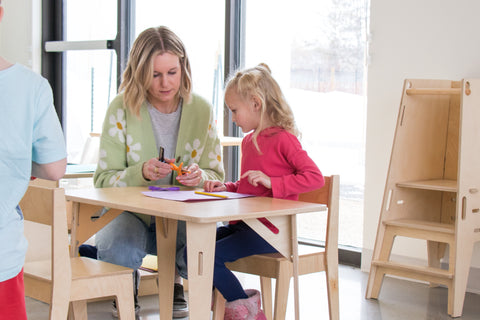A Quick Introduction!
I’m Gabrielle, an AMI-Certified Montessori educator with a Master's Degree in Child Studies. I’ve worked in Montessori Toddler and Primary (preschool) environments for almost a decade. Before I discovered Montessori, my experience with early childhood education was in public school and traditional daycare settings. Many aspects of the Montessori philosophy were foreign to me, and frankly, I was very skeptical at first! I’d like to tell you about one of my first “aha” moments as a new Montessori teacher.

In a Montessori Classroom
What do we offer children when we give them a world of “yes”? What do they learn when we tell them what they can do, instead of what they can’t do?
This perspective was one of my first eye-opening realizations when I stepped into a Montessori environment as an assistant teacher nearly ten years ago. When I first learned that we don’t say “no” to children in Montessori environments, I was perplexed. It wasn’t my first experience working with children, and I thought that saying “no” was par for the course. I heard phrases like, "Don't touch that!", "Stop running!" and "No hitting!" in every classroom I had been in before.
How could I be expected to never say no in my classroom? There are so many times that we may need to prevent children from doing something because they might hurt themselves, others, or something in their environment. Also, sometimes we just have to leave the house on time and they really do need to put their shoes on right now. There are countless reasons why we might need to maintain a boundary. Additionally, children need boundaries in order to feel safe and to be safe.
The key, I soon learned, was less about words and more about a shift in perspective. In order to make a shift from negative phrasing to positive phrasing, I had to tell children what they could do, instead of what they couldn’t do. In order to do that, I had to look at the classroom environment with new eyes; and more importantly, I had to look at the children with new eyes.
I compare the shift from negative phrasing to positive phrasing to the Pink Elephant Paradox: if I tell you not to think about a pink elephant, what are you going to think about? A pink elephant, of course!
When we say “Don’t run,” a young child hears "Run, run, run," so, naturally, that’s what they’ll do. However, when we say, “Let’s walk,” we empower a child by both helping them to understand the boundaries of the environment and by giving them the agency to do something.
Furthermore, by telling children what they can do, we are communicating that we respect them, and are asking for respect in turn. When we say, “Chairs are for sitting,” instead of “Don’t stand on the chair,” we are telling them that we believe they are capable of exercising self-control, thinking about what needs to change, and are independent enough to respect the boundaries of the environment.
Embracing this shift in perspective and incorporating it into my daily interactions with the children in my class was the start of my transformation as a Montessorian. It was the beginning of understanding what young children are capable of, giving them the tools to be independent, and treating them with respect and dignity.
Beyond the Classroom
When we talk about preparing the environment for young children, we’re really talking about creating “yes” spaces. The Montessori classroom is often referred to as a Prepared Environment. This is a space where children can move freely, where they can touch things, and explore everything. It is a space where children don’t have to be told “No, don’t touch that,” because the spaces are set up specifically for them.
We can look to Montessori classrooms for inspiration and guidance at home. At the same time, home is not school. It’s unrealistic to try to make the whole house a “yes” space, and more importantly, it’s not necessary to. I encourage parents to not put pressure on themselves to recreate the classroom at home, or to try to act like Montessori teachers with their children. We don’t need to eliminate the word “no” entirely; rather, we can use it sparingly and save it for times when it really is important.
By developing an understanding of Montessori principles and the reasoning behind them, such as why we use positive phrasing with children, we can support our children in developing independence, autonomy, and self-confidence. We can show that we respect them and that we believe in them. We can offer them a world of “yes”: a world full of endless possibilities for them to explore.
What questions do you have about Montessori education? Comment below!



